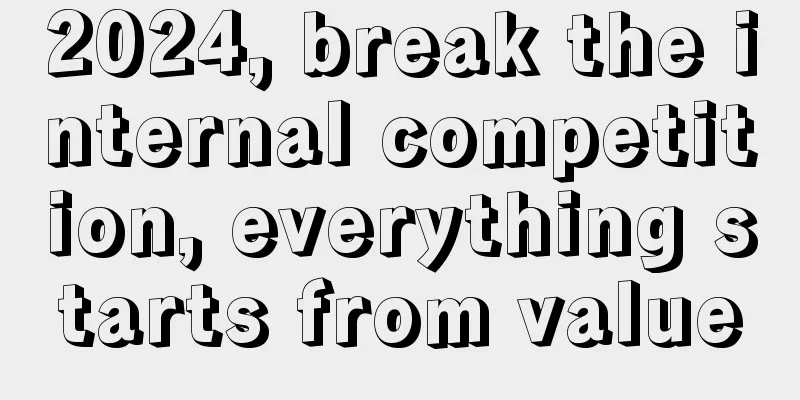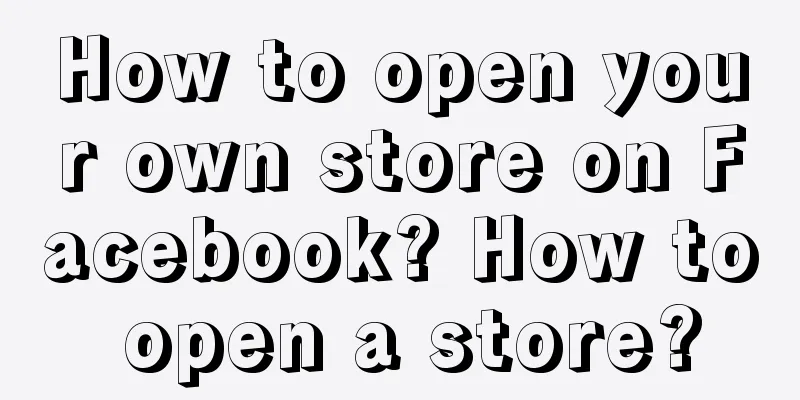2024, break the internal competition, everything starts from value

When talking about brand marketing, most people think that the most difficult part is promotion. When it comes to promotion, the default is a combination of several mainstream social media:
Investing in social media and buying traffic seem to be the universal strategy for promotion, but everyone is also trapped in the same dilemma: the cost of traffic is getting higher and higher, and the conversion rate is getting lower. If you don’t buy traffic, you will die, and if you buy traffic, you will die slowly. The biggest effort is put into ROI evaluation, studying where the traffic is and how to convert it. Insufficient investment in product development and brand building, weak competitiveness, and have to increase investment. As a result, they are kidnapped by traffic and enter a vicious cycle of drinking poison to quench thirst. They can never break through, so they come to a conclusion: the industry is getting more and more competitive, and nothing can be done. I have a deep understanding of this when I was running a restaurant from 0 to 1. In the early days of opening, the store had low customer flow, and my colleagues were anxious about whether to find a large number of experts to visit the store. Buying traffic will bring customers, and the effect will be immediate. I said that the focus in the early stage is to do product verification, run through the customer base, product combination, customer unit price, user experience, kitchen products, team cooperation and other links, avoid fatal problems, and then the focus is on promotion. Because traffic will magnify your advantages, but also magnify your weaknesses. Buying a large amount of traffic is like driving on a highway without stopping for maintenance. Problems are fatal. If you invest hastily, you may be swallowed up by the traffic. After two weeks of trial operation, we continuously optimized each link and topped the regional list of Dianping without any investment. After the official opening, we started to invest, and the turnover has steadily increased, which is on the right track. I tell this story to tell you that the fundamental way to solve problems is not external, but the core is internal thinking and perspective. The colder the winter, the more we need to cultivate our inner strength. After a year of thinking and practice, if you ask me how to do brand marketing in 2024, I would say: break the internal competition and start from value. 1. What you think is a roll may be an illusion
Rolling prices, rolling services, rolling promotions, rolling products, rolling discounts…it seems like every element is in highly saturated competition. Either you follow the lead or you get out. But the volume is just an appearance, and it may be an illusion. In my opinion, such a volume is an instinctive response without clear core values and strategic direction, which is ineffective. I summarize this ineffective involution into three aspects: 1. Being caught up in ineffective competition, focusing only on competitors and not on customersA considerable number of brands are competition-oriented, and their main daily work is to study competing products and industry trends, and then take action. Competitive thinking is reflected in all aspects: if he launches a new product with persimmon flavor, I will quickly follow up; if he co-brands Moutai, I will co-brand XX Laojiao; if he launches a low-priced meal, I will lower it even more... It seems that the market is a zero-sum game. As long as you keep pressing your opponent, you can win the market if you defeat him. But one fact is often overlooked: your consumers do not completely overlap. Even the same person will buy different products in different scenarios. When communicating with brands, I would ask: In what scenarios would target consumers buy your product? What is the core reason for purchase? What is the entire process of consumer experience and repeat purchase? Are there any pain points that have not been resolved? It turns out that very few people can fully answer this question. Insufficient investment in user research and lack of strategic focus resulted in the company being led by the nose by competitors, distorted actions, and the brand gradually losing its competitiveness, which could only be maintained by purchasing traffic and low-price promotions. 2. If there is no accumulation, it is a waste no matter how much you do.When asked about promotion, most brands focus on studying the platform’s gameplay, such as exposure, tagging, implicit implantation, customer acquisition, conversion, and amplification of private domain traffic. This is effective in the short term, but there is no fundamental breakthrough. If you change the platform, the gameplay will fail. I have a client that makes children's toys, with thousands of SKUs. The team focuses on Xiaohongshu and Douyin, and the ROI is high, but the repurchase rate is low. Research shows that they have figured out how to play the platform, but they are not good at designing the product experience. For example, the product unboxing is not amazing, there is no series product purchase guide, and there is not even a repurchase coupon. No matter how much goods are sold in this way, they are all one-time, and there is a lack of structural design that allows users to have a full-process experience. Another furniture client hired many professional designers to make products. The product designs were great, but their biggest worry was the serious plagiarism in the industry. Often, within a month after a new product came out, a competitor would come out with the same product. The materials used were not as good as theirs, but the price was much lower. After studying their product pages and materials, I found that I could not remember anything except the product specifications and selling points. There was no core brand difference, no symbol system design, and no systematic discourse. Even if I copied them completely, it would not be a big problem. Due to the lack of consumer sedimentation, we have been buying traffic and investing for many years but have not built a brand. Most people think that a brand is just a name and a logo, but in fact, every aspect of product sales and the entire process of user experience are all part of branding. Store decoration and atmosphere are part of branding, and the entire process from user ordering, experience, and feedback is also part of branding. These links can form a brand impression and eventually settle into brand assets. If we fail to establish a brand asset system and effectively convey the brand value in every link, then all the promotion will be wasted. 3. No difference and innovationThe first task of brand marketing consulting is to sort out the resources of the enterprise. We will study the development history of the enterprise and review the reasons for its success. Generally speaking, the starting point for success is to discover market opportunities and fill market gaps with innovative products to gain a competitive advantage. I have found that many companies enter a period of lack of innovation after 3-5 years of development. The reasons can be summarized as follows: The first is to immerse oneself in daily operations, busy with competition, busy with finding channels and resources, busy with consolidating the market and strengthening the moat; The second is excessive path dependence, thinking that as long as the previous daily business methods are followed, day after day, they will be fine. They are unwilling to innovate and are unwilling to take innovation risks; The third is that the supply chains are all the same now, products are highly homogenized, and it is difficult to innovate. The third point is the current situation of most companies and also the difficulty. However, as mentioned above, even the same consumer may have different demands for products in different scenarios. Similarly, the same product may appeal to different user values and have different reasons for purchase. Previously, there was a client who made ambient temperature milk in the northwest region and had always had a good reputation. Later, MengX and YiX aggressively cut prices, which cut his profits into thin air and also snatched away a lot of customers. He didn't know how to respond. Our research found that it is not advisable to engage in direct battle in regional markets dominated by giants, because you don’t have as many bullets as them. You should start from the segmented scenarios and finally find the purchase scenario of "a glass of milk before bed to calm the nerves and help sleep", focus on the segmented track, and thus extend a new product line. The population structure is changing, and consumer demand and scenarios are constantly being refined. Compared with past successful experiences, we must study what opportunities the industry will have in the next 3 to 5 years in order to find a new growth curve. During the holidays, I saw a very good sentence - We are all created by the past, but we do not have to be prisoners of the past. To summarize, there is a concept in Buddhism called "illusion", which means that external appearances are not real entities, but just a perception and expression of the world by our senses. In my opinion, involution is the same concept. It is the external attribution we make when facing a harsh environment, and it may just be an illusion. 2. The key to breaking the internal circulation is to change the mindsetTo break the internal circulation, we must first change our mindset and see the essence of the internal circulation through the layers of fog. When I communicate with clients, one of the methods I like to talk about is changing my mindset. Because companies are very familiar with their products, they think consumers should also know them. In fact, consumers' impression of your brand is a blank slate. There is another problem. Many companies are production-oriented. They first make products and then find ways to sell them to consumers. A few years ago, a brand that makes parent-child reading APP found me, and the communication goal was very clear: how to increase the average order value by 50% by 2024? I understand that it was the upper management who set the annual sales target. When broken down layer by layer, the indicators such as number of users, frequency of repeat purchases, number of new products, and referral data are very clear. For him, it means increasing the average order value. I asked him what he planned to do, and he told me to package a few new products into a combination discount package, and then add a class by a famous teacher, or organize an offline author meeting event, etc. I said, before reaching the performance indicators, let's switch to the user's perspective: Do users need this? Do they have any new needs that are not met? What new problems have we solved during their experience, so it is worth them paying 50% more? He suddenly realized something and immediately called together the class teacher and sales team to conduct an in-depth user research. This is the production mentality that many companies have, focusing only on what they have and ignoring what consumers need. I have always believed that the key to solving a problem does not lie in how sophisticated the method or technique is, but in the perspective from which one looks at the problem. To break the internal circulation, we must jump out of the vortex and reorganize our thinking perspective. Switch from focusing on competitors to focusing on users. Start from user value and see what consumers really need and what are the core reasons and scenarios for purchasing from you; From finding resources and channels to building brands. Starting from brand value, all marketing and communication actions must be accumulated into brand assets to truly form brand power and not be carried away by external traffic; Transform from homogeneous competition to incremental innovation. Starting from the value of innovation, we conduct in-depth research on market opportunities, drive growth through comprehensive innovation, and break out of low-dimensional vicious competition. 3. Everything starts from valueA change in thinking is a kind of cognition that requires concrete actions to produce results. Here I try to provide some tools and methods to help you better understand and apply user value, brand value, and innovation value. 1. User ValueToday is an era of commodity oversupply, with many brands in every category. But even for the same product, consumers have different understandings of user value and different reasons and scenarios for purchasing. Take milk as an example. If it is high in calcium, it can enter the bone growth market of teenagers. If it is high in vitamins and minerals, it can enter the health care product and gift market. If it is high in sleep, consumers will drink some before going to bed. It is the different understandings of user value that determines that for the same product, different companies have different marketing strategies and business operations, and take completely different paths. To understand user value, we must start from the real scenarios of users’ lives. Here is a tool for you: jobs to be done (JTBD). Proposed by the "Father of Innovation" Christensen, it means that when a user buys a product, he does not want to own it, but wants it to help him complete a task in the real world. That is, the product becomes a prop to achieve a certain goal in a certain scenario of the user. I made a diagram to help you better understand and apply it: Users want to achieve a certain goal in life, but due to some practical obstacles, they have to adopt more expensive alternatives. You can start from these three aspects: segmenting the population, reducing practical barriers, and splitting goals, and provide users with different values. It should be noted that the result of the user scenario analysis must be a specific story. For example, Xiao Wang (user), a 28-year-old white-collar worker who often works overtime, must eat breakfast (a certain goal) in order to ensure that he can work in the morning, but he gets up late and has no time to do it (realistic obstacles), so he can only go to the convenience store downstairs to buy bread and milk (a more expensive alternative). If your product can reduce user costs and decision-making risks, for example, it only takes 2 minutes to heat up in the microwave, is nutritious and keeps you energetic for the whole morning, tastes good and keeps you full, then you can generate new user value. Later I will introduce this model in more detail and the product examples we made using this tool. The core of brand growth is to make products a tool for users to solve real problems, such as dandruff removal = Head & Shoulders, fear of getting angry = Wanglaoji, laundry sterilization = Dettol, firmly binding brand appeal with user value. As long as people are still there, the demand is still there, and they still regard you as a solution, they will continue to choose and buy. User value does not need to be fabricated or led; it comes from the fact that it already exists but no one has discovered it. These facts are gained from insights into the subtleties of life. 2. Brand valueTeacher Feng Weidong said that "the core achievement of business operations is brand", and the ultimate and most essential reason for consumers to buy is also brand. Therefore, all marketing and communication actions should be centered around the shaping and accumulation of brand value. However, the brand marketing departments of many companies are stuck in the daily work of finding resources, channels, and promotion. A common feature is that they pursue short-term performance growth and ignore the accumulation of brand assets. They only pay attention to the amount of communication and do not delve into the quality of communication. I would like to say that the technology-driven media environment is changing very quickly, and the consumer demands intertwined with diverse cultures are also iterating very quickly. Companies have spent a lot of time and resources trying to grasp what is changing, and lack attention to what is truly scarce and unchanging. Things that change are infinite, but things that remain unchanged are limited. Enterprise resources are also limited, so we should use limited resources to grasp the limited unchanging things (it’s a bit confusing, you should think about it more). For example, channels are unlimited, influencers are unlimited, ways of playing are unlimited, and purchases are unlimited, but consumers’ cognition, memory, and impression of the brand are limited. If a brand does not have a core memory that goes straight to people's hearts, and lacks unified concepts, words, images, and actions in its communication, its voice will inevitably be drowned out in the noisy competitive environment and it will not be able to form a foundation. To build brand assets, I have sorted out the following model and some implementation elements. You can refer to this table to organize your own brand assets. Only when all marketing and communication actions are accumulated into brand assets can consumers form a stable brand perception, thereby realizing the role of brand assets:
Continuously reduce brand communication costs and truly "save" the promotion money into the brand piggy bank to generate compound interest. 3. Innovation valueThere are many theoretical methods for corporate innovation, and I prefer Schumpeter's innovation theory. He said that only through innovation can enterprises obtain excess profits. Innovation is not invention, but "recombination of production factors". Only innovation can make products more competitive and get rid of low-dimensional homogeneous competition. He summarized five innovation methods:
Later, people summarized these five innovations into resource allocation innovation, technological innovation, product innovation, market innovation, and organizational innovation. However, these innovations are not separated from each other, but rather intertwined, and each link also includes product innovation. Taking the milk example above, the milk market has been around for a long time and competition is almost saturated. What innovations have there been?
Comparing these innovation elements, you will find that even the most common products have opportunities for innovation. You may say that the milk market developed early, which is why there are so many innovative results. You are in an emerging industry and everything is still under exploration. Then you should be even more fortunate, because there is still a lot of room for innovation waiting to be explored. If you find it, it will reward you in the form of wealth. To sum up, based on different understandings of user value, there will be different brand appeals. Through the combination of innovation in products, technology, channels, and experience, we can open up new markets and get rid of homogeneous competition. Even if two products are exactly the same, they are not completely homogeneous in the market. The so-called homogeneous competition is only because you have not found better consumption scenarios and innovation methods. Final ThoughtsOver the years, I have come into contact with many excellent companies, including those that have grown against the trend. While others are following suit, they have always centered their business around user value. Brands that have transcended cycles all regard brand value as their most valuable asset. In the face of new environmental challenges, they continue to open up new territories with innovation. Sustained growth comes from strategic focus + brand accumulation + effective business operations in response to environmental changes. There is no unchanging growth path, nor is there a panacea for growth. The path to success for every person and every company is a combination of personal struggle and the luck of the times. The key is to always maintain an empty cup mentality, not be bound by past experiences, and not be deterred by future challenges. In 2024, new technologies will emerge, and users, media, and gameplay will continue to change. I wish you to step into the new year with firm beliefs and the perspective of user value, brand value, and innovation value. Author: Su Laoshi Source: WeChat public account "Su Lao Shi" |
<<: Short drama successfully sneaks into the Spring Festival schedule
Recommend
Seizing the social and emotional needs of young people, offline catering breaks through the scene
As consumers' demands are constantly changing,...
TikTok has joined the price war, but which sheep is being fleeced?
Now more and more platforms are engaging in price ...
Do I need an external network to open a store on Amazon? Do I need to bypass the firewall?
If you want to register on Amazon, you need to sub...
Carrot Run "Information Explosion"
Baidu's Carousel has recently become a frequen...
How to find the source of goods when opening a store in Wish? Is it profitable to open a store?
With the rapid development of the e-commerce indus...
New rules for Douyin e-commerce are here! A large number of merchants have been closed down and deducted money. What should they do?
I believe that everyone often shops on e-commerce ...
The most discouraging Spring Festival marketing campaign in the Year of the Snake! Major brands are rolling up their sleeves
As the Spring Festival of the Year of the Snake ap...
What is the fundamental reason why the new top-selling horse-faced skirt has sold 300 million copies?
Recently, the horse-face skirt has been all over t...
This Double 11, we went to Li Jiaqi's live studio
Since the eyebrow pencil incident, Li Jiaqi has be...
What should I pay attention to when modifying the title on Shopee? How to choose words?
Merchants who run online stores all know that afte...
What is the difference between the popular social networking and circle social networking?
This article uses a social and psychological persp...
What is the process for opening a store on Amazon? Can an individual open a store on Amazon?
As one of the world's largest e-commerce platf...
How does Amazon shut down a site? How to do it?
As the Amazon platform continues to grow, more and...
Don’t use the logic of Tik Tok to create Xiaohongshu!!!
There are huge differences between the two platfor...
Bawang Tea Princess: A consumer product that takes Internet thinking to its extreme
In mid-August, Bawang Chaji announced the "ca...









